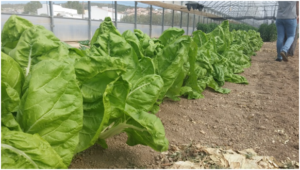 Although the product has been developed and tested since 2010 in collaboration with reputed multinational fertilizing companies within the frame of a confidential research and development project named CENIT VIDA, this year AlgaEnergy is undertaking a considerable number of deeply monitored field trials to demonstrate the benefits of its biostimulant AgriAlgae®, in all kinds of crops.
Although the product has been developed and tested since 2010 in collaboration with reputed multinational fertilizing companies within the frame of a confidential research and development project named CENIT VIDA, this year AlgaEnergy is undertaking a considerable number of deeply monitored field trials to demonstrate the benefits of its biostimulant AgriAlgae®, in all kinds of crops.
IMIDRA –Madrid’s Institute for Research in Rural Development and Food- is carrying out studies in the cultivation of melon, in order to consolidate last year’s trials, whose results were outstanding. IMIDRA is also carrying outfield trials on the cultivation of pepper, tomato and vineyards, and even in different kinds of flowers.
Another example is the agreement AlgaEnergy has reached with the University of Cordoba, which is likewise studying the results of AgriAlgae® in olive trees in a two-year-project led by Prof. Luis López-Bellido, a renown authority in the field of olives production.
Within our borders, the CSIC – Spanish Center for Scientific Research – is also conducting tests on organic cereal crops, amongst many other institutions and companies. At an international level, the product’s performance is also being challenged, so far only with positive results across all continents, including Europe, Africa, Central and Latin America, Asia or Australia. For instance, the University of Wageningen in the Netherlands is carrying out field trials to find out if AgriAlgae® can potentially contribute to partially reduce the usage of phytosanitary treatments in certain crops.
“All these trials seek to corroborate through independent centers results what we have already verified through our network of more than 500 customer-partners“, highlights María Segura, Technical Director of AlgaEnergy. “AgriAlgae® is a product that, unlike any other biostimulant in the market, provides any plant with the 20 L-amino acids it needs for an optimal development, as well as vitamins, phytohormones, minerals, peptides, pigments and a long list of beneficial components. Thanks to the mixture of microalgae strains used in the composition of AgriAlgae®, all these substances are present in an optimized proportion. Due to this circumstance, it is not uncommon to obtain outstanding results in the field trials“.
The main benefits of using AgriAlgae®, already confirmed by the company through its extensive partners’network, are:
- Increased yields, due to an improved efficiency of the plant’s nutrition
- Better quality traits: larger and heavier fruits, better coloring, increased Brix degree, caliber homogenization, etc.
- Increased resistance to stress when applied before a stressful situation, improved recovery if applied after the stress
So far, all these effects have been verified, resulting in double-digit performance increases not only when compared to crops in which no biostimulant had been used, but also when matchedwith yields obtained in crops treated with other products of reference in the sector.
Another important factor is the better flavor developed by the fruits treated with AgriAlgae®. “Although it may seem strange, the taste of a fruit or vegetable is also improved as a result of using AgriAlgae®, which was confirmed by the report that iMiDRA drove with melon cultivation in 2016,” ratifies AlgaEnergy’s Technical Director. “AgriAlgae® does not provide any taste to the fruit, but it enables the plant to optimally absorb nutrients and keeps it healthy, allowing it to synthesize sugars and mature at the right time. AgriAlgae® does not change the flavor, but helps the fruit to boost its original taste, an asset that is very valued by the final consumer.”
With all the independent tests scheduled for this year, AlgaEnergy seeks to demonstrate the reasons why microalgal industry is being coined as “the agro-industry for the future”, amongst which we find not only the exceptional results provided by AgriAlgae®, but also to the fact that, for each 5 L of product used, 2kg of CO2 have been bio-fixated by the microalgae in AlgaEnergy’s production process, avoiding that this noxious gas is emitted to the atmosphere.
